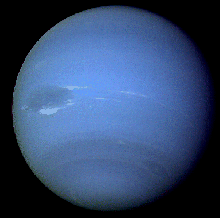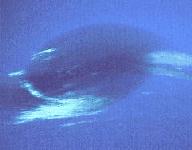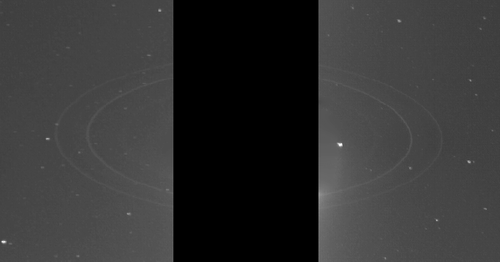|
 Neptune
is like Uranus in many ways, but has its own unique features. Because of Pluto's highly
elliptical
orbit, it is currently the most distant planet from the Sun, at a separation
of about 30 Astronomical Units. The full disk of Neptune in shown in the adjacent image
(Ref).
Neptune
is like Uranus in many ways, but has its own unique features. Because of Pluto's highly
elliptical
orbit, it is currently the most distant planet from the Sun, at a separation
of about 30 Astronomical Units. The full disk of Neptune in shown in the adjacent image
(Ref).
Neptune has been particularly challenging to study from the ground because
its disk is small and badly blurred by the Earth's atmosphere at that distance.
In spite of this, ground-based astronomers had learned a great deal about this
planet since its position was first predicted by Adams and Leverrier in 1845.
However, our most detailed information about Neptune has come from the Voyager 2 flyby in 1989.
General Features
Neptune is currently the most distant planet from the Sun, with an orbital radius of 30
Astronomical Units and an orbital period of 165 years.
Its diameter is about four times that of the Earth, which makes it the 4th largest planet.
It is slightly smaller than Uranus, but its density is 1.6 g/cc (compared with 1.2 g/cc for Uranus),
which makes it the 3rd most massive planet.
The relatively low density indicates large concentrations of hydrogen and
helium, but Uranus and Neptune both have much larger concentrations of heavier
elements than Jupiter and Saturn. As for all the gas giant planets, models
suggest rocky cores of maybe 15 Solar masses, but there is no direct confirmation of this.
The bluish color of the adjacent image is, as for Uranus, because of methane in the atmosphere, which
absorbs red light, leaving the light scattered from Neptune preferentially
enhanced at blue wavelengths. The period of rotation is about 16 hours,
comparable to that of Uranus and much slower than for Jupiter and Saturn. The
temperatures at the cloud tops are about -216 degrees Celsius, slightly warmer
than for Uranus. Neptune, like Jupiter and Saturn but unlike Uranus,
has an internal heat source and produces 2.7 times more heat than it absorbs.
The Surface and the Interior
 The Voyager 2 flyby in 1989 revealed strong winds, bright, high-altitude clouds, and two large
dark spots attributed to long-lived giant storm systems.
Tracking of these features indicated wind speeds as large as 730 miles per hour. The largest dark storm systems, called
the "Great Dark Spot", is shown in the image adjacent left.
It resembles Jupiter's Great Red Spot
(more info).
The Voyager 2 flyby in 1989 revealed strong winds, bright, high-altitude clouds, and two large
dark spots attributed to long-lived giant storm systems.
Tracking of these features indicated wind speeds as large as 730 miles per hour. The largest dark storm systems, called
the "Great Dark Spot", is shown in the image adjacent left.
It resembles Jupiter's Great Red Spot
(more info).
The interior is presumed to contain a rocky core with an icy mantle topped by a
deep layer of liquid hydrogen. Voyager 2's instruments detected a complex
magnetic field. Like Uranus, the field is tipped with respect to the axis of
rotation and offset from the center (the tilt is 50 degrees for Neptune,
compared with 60 degrees for Uranus). However, the field is somewhat weaker than for Uranus.
As for Uranus, it is speculated that this magnetic field my originate in a
conducting shell not far below the clouds, rather than deep in the interior as
for Jupiter or the Earth. In that case, the conducting material would not be
metallic hydrogen, as for Jupiter, or iron and nickel, as for the Earth. As
noted earlier for Uranus, a mixture of water, methane, and ammonia under the
right pressure could be responsible.
The Rings
Neptune's rings were first detected in star occultation experiments from Earth
in 1983, but they were very difficult to study before the data from Voyager 2.
The following image
(Ref)
shows the faint rings of Neptune (the light from the body
of the planet is blocked off in the black region to allow the rings to be seen clearly).
 |
| The Faint Rings of Neptune |
Only the two brightest rings show clearly in this image. Voyager 2 found additional fainter rings.
The rings rotate in the same direction as the planet and are nearly in the equatorial plane.
The material in one of the rings is clumpy (more dense in some regions than others). This gave the impression in
ground-based observations that the rings were arcs instead of complete rings,
but the Voyager 2 data showed that they were complete rings. The rings of
Neptune contain much more dust-size grains than the corresponding rings of
Saturn and Uranus, and are quite narrow (about as narrow as the Saturn F-ring).
The Moons
 Neptune has two large moons that are easily seen from Earth, Triton and Nereid.
Voyager 2 discovered six additional moons. One of these is actually larger than Nereid,
but could not be seen easily from Earth because it orbits close to Neptune.
Neptune has two large moons that are easily seen from Earth, Triton and Nereid.
Voyager 2 discovered six additional moons. One of these is actually larger than Nereid,
but could not be seen easily from Earth because it orbits close to Neptune.
Triton
The image on the right
(Ref)
shows a portion of the southern region of Triton, Neptune's largest moon, taken in 1989 by
Voyager. Triton is comparable in size with our own moon, and has a thin atmosphere, mostly of nitrogen.
The polar ice cap in this image is probably mostly nitrogen ice.
Triton orbits Neptune with retrograde motion, which probably means that it is a captured object.
Voyager 2 found some of the most varied terrain in the Solar System, a thin atmosphere, and even
evidence for ice volcanoes on Triton.
The dark streaks seen in this image are material spread downwind from recent volcanic eruptions. Giant faults cross the surface
of Triton. The favored mechanism for the volcanoes is that the Sun heats
darkened methane ice on the surface, which heats underlying nitrogen ice that vents through the surface volcanoes
(more info).
The New Moons of Neptune
The six newly-discovered moons orbit with direct motion nearly in the
equatorial plane. Most are closer to Neptune than its rings. Because this
lies inside the Roche limit, these moons could not have formed by accretion in
their present location. They must have formed elsewhere before coming to their
present orbits, though we are not certain where.
| 

